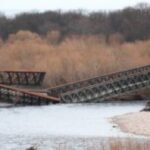Scotland is grappling with the driest start to the year since 1964, prompting Scottish Water to urge residents to be cautious with their water use. The unusually dry spell has pushed demand up by about 150 million litres daily since mid-April, stretching supplies in several areas.
With river levels dipping dangerously low and no rain forecast for at least a week, the pressure on water resources is mounting. While a full hosepipe ban isn’t in place yet, Scottish Water is already taking steps to top up supplies and asking the public to cut back on non-essential water use.
Water Scarcity Hits Major Scottish Regions
Scottish environmental agency Sepa has flagged 23 locations across the country facing water scarcity, including some near major rivers and firths like the Clyde, Dee, Firth of Forth, and Firth of Tay.
The situation is particularly tricky in places like Potterton near Aberdeen, Turnberry in South Ayrshire, and Balfron in west Stirlingshire, where water tankers are supplementing normal supplies.
In Moray, authorities have boosted borehole supplies by pumping water directly from the River Spey to keep reservoirs topped up. This stopgap measure reflects just how strained the system has become.
The problem isn’t just about running low on water. It’s about managing what remains carefully. Scottish Water CEO Alex Plant stressed that much of the increased demand stems from garden watering, saying, “We believe that a large part of the additional water use at the moment is in gardens.” He urged residents to “be mindful” of their water consumption.

What Scottish Water Recommends for Saving Water
Scottish Water isn’t calling for a total hosepipe ban just yet—something last seen in 1995—but it is pushing for sensible habits. Here are some of the tips they’ve shared:
-
Use a watering can instead of a hose to water plants.
-
Avoid sprinklers altogether.
-
Take shorter showers.
-
Turn off the tap when brushing teeth.
-
Only run washing machines and dishwashers when full.
-
Wash cars with a bucket and sponge rather than a hose.
These may sound like simple steps, but collectively they can make a significant difference.
A quick look at the numbers shows how much water this could save daily.
| Activity | Average Water Use per Hour/Session | Potential Water Saved by Adjusting Habits |
|---|---|---|
| Garden hose use | 540 litres/hour | Up to 100% reduction if avoided |
| Sprinkler use | 1,000 litres/hour | Complete avoidance saves all |
| Shorter showers (reduce by 2 min) | 30 litres/minute | 60 litres saved per shower |
| Washing machine (full load) | 50 litres | Avoid half loads saves up to 25 litres |
Simple, but effective.
Scotland’s Climate and What’s Behind the Drought
The weather hasn’t been on Scotland’s side this year. From January through April, rainfall was only 59% of the long-term average. May looks even drier, with no rain expected until at least May 22, according to forecasts.
Tuesday saw some parts of Scotland reach 25°C, the hottest day so far this year. Such temperatures ramp up water use as people try to keep gardens green and stay cool, but they also accelerate evaporation from rivers and reservoirs, making the situation worse.
Plant’s remarks point to a bigger picture: “Scotland’s climate as a whole is changing.” While short dry spells happen, the trend toward hotter, drier weather in the spring months is worrying. It’s a reminder that water management can’t rely solely on old assumptions.
How the Public is Responding
From the sound of things, people are trying to pitch in. Garden centers have seen a rush of watering cans and water-saving gadgets flying off the shelves. Yet, despite warnings, some stubborn habits persist. Sprinklers are still humming in suburban neighborhoods, and hoses are being dragged out for car washes on sunny afternoons.
One local gardener in Aberdeen told reporters, “Yeah, I’m trying to be careful, but it’s hard when everything’s brown and crispy.” It’s a familiar feeling — balancing the urge to keep things alive with the need to conserve water.
Others have found creative ways to stay green, like collecting rainwater in barrels during the occasional downpour or watering plants early in the morning or late at night to reduce evaporation.
What Could Happen Next?
If the dry spell continues, Scottish Water might have to rethink restrictions. The last hosepipe ban was back in 1995, but it’s not impossible that similar measures could return if river levels and reservoirs drop further.
For now, authorities are watching the weather and water supplies closely. If you’re in Scotland, it’s worth paying attention. The simple act of turning off that hose for just a day or two could help keep the taps running for everyone.


















